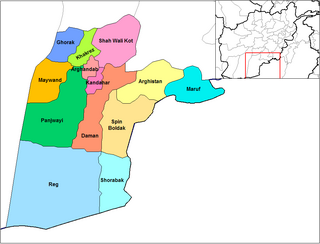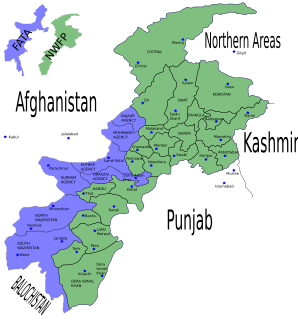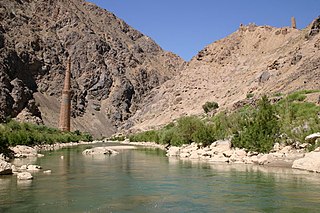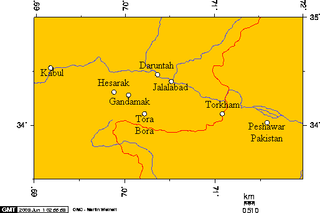 W
WThe Battle of Ahmed Khel was fought between the British Empire with its British and Indian armies and the Afghans, on the road between Kandahar and Kabul in Afghanistan on 19 April 1880. The battle occurred during General Donald Stewart's march from Kandahar to Kabul via Ghazni, and ended in a British victory.
 W
WThe Battle of Ali Masjid, which took place on 21 November 1878, was the opening battle in the Second Anglo-Afghan War between the British forces, under Lieutenant-General Sir Samuel James Browne, and the Afghan forces, under Ghulam Haider Khan. The perceived offence of an Afghan general's refusal to allow a British envoy entrance to the country was used as an excuse to attack the fortress of Ali Masjid, as the opening battle in the war. Despite numerous setbacks, including half the troops getting lost or delayed and missing the battle entirely, the British were lucky that the Afghans abandoned their position overnight.
 W
WThe Battle of Arghandab was an offensive launched by Afghan government forces, supported by Soviet troops against Mujahideen strongholds in the Arghandab District of Kandahar Province, Afghanistan. The operation ended in failure, and the government forces withdrew after suffering heavy losses.
 W
WIn January 1505, Babur set out from Kabul towards India and proceeding by way of Badam Cheshmeh and Jagdalak reached Adinapur (Jalalabad). Nasir Mirza, his younger brother, joined him here. As the Aimaqs of that neighborhood with their followers had moved down with all their families into Lamghanat for the purpose of wintering there, they waited for this group and others till they were joined by them after which the army went on to Kush Gumbez lower down than Jui Shahi. Nasir Mirza having made some provision for his dependents and followers from the country under his government stayed behind at Kush Gumbez promising to follow in two or three days.
 W
WThe Battle of Damghan or Battle of Mehmandoost was fought on September 29 to October 5, 1729, near the city of Damghan. It resulted in an overwhelming victory for Nader and the Safavid cause he had taken up, though by itself it did not end Ashraf's rule in Persia, it was a significant triumph which led to further successes in the following engagements of the campaign to restore Tahmasp II to the throne. The battle was followed by another one in Murcheh-Khort, a village near Isfahan. Nader's forces were victorious in both battles, which led him to remove the Ghilzai Afghan dynasty from their short stay on the Persian throne. The Hotakis were forced back to their territory in what is now southern Afghanistan.
 W
WThe Battle of Zarghan was the last battle of Ashraf Hotaki's career as a statesman. Having been repeatedly bludgeoned by Nader's army through the Battles of Mihmandoost and Murche-Khort Ashraf had withdrawn from Isfahan and escaped south to Shiraz to rebuild his army in an ultimately futile attempt to reverse his fortunes. Although he found some local support amongst a few of the tribes he was decisively beaten, for the last time, after which he disappeared from Persia as well as the historical records, with no consensus being reached concerning the manner of his demise.
 W
WThe Battle of Darzab was a major conflict between the Taliban and the Islamic State's Khorasan Province (ISIL-K) who fought each other over control of Jowzjan Province's Darzab District in Afghanistan. Following heavy clashes, ISIL-K was defeated, with most of the group's forces in Jowzjan Province killed or captured.
 W
WThe Battle of Farah began on 14 May 2018, when Taliban fighters launched an assault on the city of Farah, located in western Afghanistan.
 W
WThis article covers a part of the contemporary Afghan history that started between 28 April 1992, the day that a new interim Afghan government was supposed to replace the Republic of Afghanistan of President Mohammad Najibullah, and the Taliban's conquest of Kabul establishing the Islamic Emirate of Afghanistan on 27 September 1996.
 W
WBattle of Kabul refers to a series of intermittent battles and sieges over the city of Kabul during the period of 1992–1996.
 W
WThe Ghazni offensive began on 10 August 2018, when Taliban fighters launched an assault on the city of Ghazni, Afghanistan's sixth largest city and one which has been culturally and strategically important for much of the country's history. The attack resulted in the deaths of hundreds of insurgents, soldiers, police, and civilians. The city also sustained large-scale property damage. The battle, occurring only weeks before Afghanistan's 2018 parliamentary election, was the largest since a three-day truce in June had raised hopes of peace talks.
 W
WThe Battle of Gulnabad was fought between the military forces from Hotaki Dynasty and the army of the Safavid Empire. It further cemented the eventual fall of the Safavid dynasty, which had been declining for decades.
 W
WThe Battle of Jamrud was fought between the Emirate of Afghanistan and the Sikh Empire on 30 April 1837. It was the last effort made by Emir Dost Mohammad Khan to recapture the former Afghan winter capital of Peshawar. Afghan forces confronted the Sikh forces at Jamrud. The garrisoned army was able to hold off the Afghans till Sikh reinforcements arrived to relieve them.
 W
WThe Jani Khel offensive was launched by the Taliban and the Haqqani network in early August 2016 to conquer the Jani Khel District within the contested Paktia Province from government forces. Due to the district's geographic location, it is of great strategic and tactical value to any force that controls it. After being besieged by insurgents for weeks and not receiving any outside help, the local government forces retreated from the district on 27 August. Even though the district was retaken by the government on 5 September, the fact that the district had been captured by the Taliban in the first place was widely considered a heavy blow for the government, which faced increasing insecurity and loss of territory since the ISAF retreat in 2014.
 W
WThe Battle of Jellalabad in 1842 was an Afghan siege of the isolated British outpost at Jellalabad about 80 miles (130 km) east of Kabul. The siege was lifted after five months when a British counterattack routed the Afghans, driving them back to Kabul.
 W
WThe Battle of Kabul was part of a punitive campaign undertaken by the British against the Afghans following the disastrous retreat from Kabul. Two British and East India Company armies advanced on the Afghan capital from Kandahar and Jalalabad to avenge the complete annihilation of a small military column in January 1842. Having recovered prisoners captured during the retreat, the British demolished parts of Kabul before withdrawing to India. The action was the concluding engagement to the First Anglo-Afghan War.
 W
WAfter the succession of setbacks the Abdalis of Herat had faced in the campaign Allahyar Khan decided to sully out for a last engagement to decide the issue. Unfortunately yet again the charge of the Afghan horsemen was broken up by the disciplined fire of the Persian line musketeers and flank attacks by the supporting Persian cavalry. Allahyar Khan was left no choice but to withdraw his battered army behind the walls of Herat in the hopes of withstanding the coming siege. An intense bombardment of the city ensued with heavy cannon and mortars battering the city's defences. After consulting with his advisers Allahyar Khan was convinced of the futility of further resistance. Peace terms were offered and the Abdalis agreed to sear fealty to Tahmasp II as the rightful ruler of Persia and Herat. Thus the Abdalis were brought under Persian suzerainty.
 W
WThe Battle of Kafer Qal'eh was a series of clashes which decided the outcome to the Herat Campaign. In its culminating stage the battle bears some resemblances to the battle of Sangan although it was both preceded and succeeded by numerous other minor skirmishes and engagements.
 W
WThe Battle of Kandahar, 1 September 1880, was the last major conflict of the Second Anglo-Afghan War. The battle in southern Afghanistan was fought between the British forces under command of General Roberts and the Afghan forces led by Ayub Khan. It ended with a decisive British victory, having inflicted nearly 3,000 casualties in total on the routed Afghans.
 W
WThe Battle of Kunduz took place from April to October 2015 for control of the city of Kunduz, located in northern Afghanistan, with Taliban fighters attempting to seize the city and displace Afghan security forces. On 28 September 2015, the Taliban forces suddenly overran the city, with government forces retreating outside the city. The capture marked the first time since 2001 that the Taliban had taken control of a major city in Afghanistan. The Afghan government claimed to have largely recaptured Kunduz by 1 October 2015 in a counterattack, although local sources in the city disputed the claim made by government officials.
 W
WThe Battle of Maiwand on 27 July 1880 was one of the principal battles of the Second Anglo-Afghan War. Under the leadership of Ayub Khan, the Afghans defeated a much smaller force consisting of two brigades of British and Indian troops under Brigadier-General George Burrows; albeit at a high price: between 2,050 and 2,750 Afghan Pashtun warriors were killed, and probably about 1,500 wounded. British and Indian forces suffered 969 soldiers killed and 177 wounded.
 W
WOperation Mountain Fury was a NATO-led operation begun on September 16, 2006 as a follow-up operation to Operation Medusa, to clear Taliban rebels from the eastern provinces of Afghanistan. Another focus of the operation was to enable reconstruction projects such as schools, health-care facilities, and courthouses to take place in the targeted provinces.
 W
WPanjshir Front was a military association of the Afghan opposition in the Panjshir Valley during the Soviet–Afghan War (1979–1989) under the command of field commander Ahmad Shah Massoud. The Panjshir Front played a leading role in organizing and coordinating the military and political activities of the fronts by the type of the Islamic Army – the Islamic Society of Afghanistan – in five (5) northeastern provinces adjacent to Panjshiru: Kunduz, Baghlan, Takhar, Parvan, Kapisa.
 W
WThe Panjshir offensives were a series of battles between the Soviet Army and groups of Afghan Mujahideen under Ahmad Shah Massoud for the control of the strategic Panjshir Valley, during the Soviet–Afghan War in the period from 1980 to 1985.
 W
WThe Battle of Peiwar Kotal was fought on 28–29 November 1878 between British forces under Sir Frederick Roberts and Afghan forces under Karim Khan, during the opening stages of the Second Anglo-Afghan War. The British were victorious, and seized the strategic Peiwar Kotal Pass leading into Afghanistan.
 W
WThe Sabzevar expedition was a politically decisive event in Nader's career where he in effect turned from mere commander-in-chief of Tahmasp's forces into the real power behind the throne. The expedition was launched mainly due to Tahmasp's own incompetence and ill-thought attempt at curbing the powers of his upstart general and military genius.
 W
WThe final and complete withdrawal of Soviet combatant forces from Afghanistan began on 15 May 1988 and ended on 15 February 1989 under the leadership of Colonel-General Boris Gromov.
 W
WOperation Storm-333 was a covert operation that took place on 27 December 1979, in which Soviet special forces stormed the Tajbeg Palace in Afghanistan and assassinated People's Democratic Party General Secretary Hafizullah Amin. Tajbeg Palace was guarded by Afghan National Army. In the ensuing battle, Afghan armed forces suffered major losses. 30 Afghan palace guards and over 300 army guards were killed while 150 were captured. Amin's 11-year-old son died from shrapnel wounds. A total of 1,700 Afghan soldiers surrendered to Soviet troops and were taken as prisoners. The Soviets installed Babrak Karmal as Amin's successor.
 W
WThe Battle of Tora Bora in June 2017 was a military engagement for the cave complex of Tora Bora and its surroundings in Afghanistan. Fighting took place between the Islamic State of Iraq and the Levant – Khorasan Province (ISIL-K) and forces opposed to it, namely the Taliban, militias formed by the population of the Pachir Aw Agam District, and the Afghan National Army. After heavy clashes ISIL-K forces initially succeeded in capturing Tora Bora from the Taliban on 13–14 June 2017, but Afghan government forces retook the cave complex by 17 June.